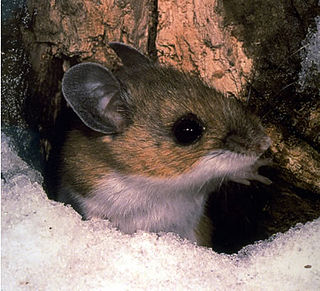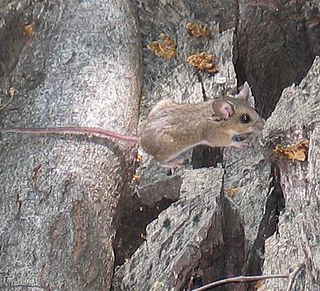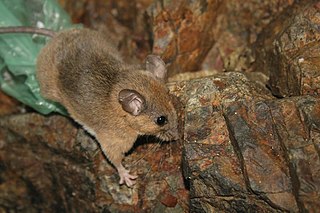Peromyscus is a genus of rodents. They are commonly referred to as deer mice or deermice, not to be confused with the chevrotain or "mouse deer". They are New World mice only distantly related to the common house and laboratory mouse, Mus musculus. From this relative, Peromyscus species are distinguished by relatively larger eyes, and also often two-tone coloring, with darker colors over the dorsum (back), and white abdominal and limb hair-coloring. In reference to the coloring, the word Peromyscus comes from Greek words meaning "booted mouse". They are also accomplished jumpers and runners by comparison to house mice, and their common name of "deer mouse" is in reference to this agility.
Schmidly's deer mouse, is a recently described species of deer mouse from the mountains of western Mexico. It is part of the highly complex and well-studied Peromyscus boylii species complex. The uniqueness of Peromyscus from this area had long been suspected, but was only formalized in 2004 with the publication of its species description. The species was named in honor of David J. Schmidly, a mammalogist and former president of the University of New Mexico.

The Neotominae are a subfamily of the family Cricetidae. They consist of four tribes, 16 genera, and many species of New World rats and mice, predominantly found in North America. Among them are the well-known deer mice, white-footed mice, packrats, and grasshopper mice.

Peromyscus maniculatus is a rodent native to eastern North America. It is most commonly called the eastern deer mouse; when formerly grouped with the western deer mouse, it was referred to as the North American deermouse and is fairly widespread across most of North America east of the Mississippi River, with the major exception being the lowland southeastern United States.

The Mexican volcano mouse is a species of rodent in the family Cricetidae endemic to high elevation areas of the Trans-Mexican Volcanic Belt.

The Aztec mouse is a species of rodent in the family Cricetidae, native to southern Mexico and parts of Central America.

The brush mouse is a species of rodent in the family Cricetidae. It is found in mountainous areas of Mexico and the western United States at altitudes over 2,000 m (6,600 ft).

The Perote mouse, or Perote deer mouse, is a species of rodent in the family Cricetidae. It is found only in Mexico.

The Zacatecan deer mouse or southern rock mouse is a species of rodent in the family Cricetidae. It is found only in Mexico, and is not considered endangered.
The blackish deer mouse is a species of rodent in the family Cricetidae found only in Mexico, and is relatively poorly studied.
The Angel Island mouse, or La Guarda deermouse, is a species of rodent in the family Cricetidae.
Hooper's mouse is a species of rodent in the family Cricetidae. It is the only member of the Peromyscus hooperi species group, and is found only in Mexico. The species is named for Emmett Hooper, a researcher into the taxonomy of the genus Peromyscus.
The nimble-footed mouse is a species of rodent in the family Cricetidae. It is found only in Mexico.

The Tres Marías island mouse or Tres Marías deer mouse is a species of rodent in the family Cricetidae. It is found only on the Islas Marías off the west coast of Mexico. When last assessed, it was common on María Cleofás Island, but rare or absent on the other, more disturbed, islands.

The black-eared mouse, or black-eared deer mouse, is a species of rodent in the family Cricetidae, native to North America.

The northwestern deer mouse or Keen's mouse is a species of rodent in the family Cricetidae. It is found in British Columbia in Canada and in Alaska and Washington in the United States. It was named after the Rev. John Henry Keen in 1894.
The tawny deer mouse or marsh mouse is a species of rodent in the family Cricetidae. It is found only in Mexico.
The false canyon mouse or Coronados deer mouse, is a species of rodent in the family Cricetidae. It is known only from Coronados Island, a small island in the Gulf of California, part of Baja California Sur, Mexico. The species is threatened by predation by feral cats, and the IUCN has assessed its conservation status as "critically endangered".

The Nayarit mouse or Sinaloan deer mouse is a species of cricetid rodent endemic to Mexico. It was considered a subspecies of brush mouse until 1977.
The Chiapan deer mouse is a species of rodent in the family Cricetidae. It is found only in Mexico.












